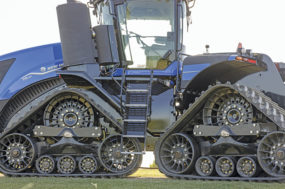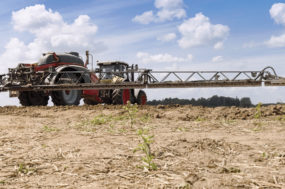I’d like to cover two topics here: welding really thin material and welding things other than mild steel.
Thin material
Just to prove it could be done, I welded up a cheap wheelbarrow that had rusted out around the holes the bolts went through to hold the bucket to the frame, using an arc welder and 6011 rod. I was close to two hours. To replace the wheelbarrow would have cost about $29 plus some beer money for the governor. Possible, yes, but practical? No.
Metal is going to travel from the electrode to the work piece. The heat required for this to happen is adequate to melt through the parts being repaired, leaving a bigger hole and an exasperated operator. Two methods of making a repair with a stick welder are multiple “tack” motions and metal spray. Both take time and patience to accomplish.
Strike an arc, as close to the site of the repair as possible. Move the arc to where you’re melting two pieces together or trying to fill a rust hole. As soon as there’s a spot of metal sticking to the work piece, pull the rod away, breaking the arc. Welding two thin pieces together, make a tack and another like an inch away. When things have cooled a bit, go back and tack again, until you’ve repeated enough to have the thin pieces firmly melted together with the multiple tacks.
Thin material will warp out of shape from heat easier than heavier metal. By using many small tacks and letting it cool between, this can be minimized. “Persuading” with a hammer may help it take or retain the shape wanted.
I was introduced to the metal spray technique when I was fighting with cracks in the frame of a hay bale conveyor. The directions I got were to strike my arc, then hold it as far as I could away from the work without breaking the arc, and letting the arc carry droplets of molten metal to where I needed to add metal. Probably a second or so and then stopping and seeing if I was helping, then doing it again.
I questioned the strength of such a weld.
“Two pieces of steel four times the thickness of tinfoil are not very strong to start with,” was the response.
Just like making multiple tacks that glom some molten metal to the work pieces, metal spraying will glom steel onto existing steel without just burning a big hole and making it worse. You’ll eventually have enough gloms of steel built up so your weld repair will actually be to the sprayed or tacked “gloms” that stuck to the work piece.
Welding with an oxyacetylene (or oxypropane) torch is another method that works for very thin metal. The torch gently heats the parent metal to the point of melting when a filler rod is brought into the heat and a bit melts and flows to the pieces being welded together.
It’s very similar to brazing with the exception that often a brazing flux needs to be present to “sanitize” the work area so the brass filler will adhere properly to the broken steel parts. Note that once brass alloy has been added to a repair that electric welding, either stick or wire feed (MIG) may not be possible. (The brass does not “alloy” with the steel; rather, it adheres to it, similar to soldering.)
Sometimes a wire feed or “MIG” welder can be turned down low enough to weld very thin material. A wire feed welder sends a filler wire through a cable, and the very tip of it is energized to carry the electricity that heats the work and the wire to melt things into (hopefully) one strong piece of steel.
The three varieties of wire feed welders I’m aware of (for welding steel) are flux core, gas shielded and dual shield.
The flux core is usually an entry-level machine for light duty and thinner metal. The wire is hollow, with a flux, similar in function to the flux on the outside of a stick welding electrode.
The next step is the gas shielding wire feed. Some of these will also run the flux core wire, making it a heavier-duty welder without needing to deal with shielding gas. A non-oxidizing gas is blown out the tip of the welder where the wire moves and melts into the work pieces. On all the wire feed machines, a trigger switch on the handle turns on and off both the wire, electrical current and shielding gas, if any is used. Common wire sizes on these machines are 0.030 inch and 0.035 inch.
The dual shield wire feed is the big brother. It uses flux core wire, usually starting at 0.045 inch in addition to shielding gas. It’s definitely not for thin material.
The TIG process is often used for thin material. For explanation, I’ll liken it to oxyacetylene welding using a gas-shielded electrode to make the heat and a filler rod compatible to the work pieces to add material, the torch in one hand, the filler rod in the other.
Same as using a stick welder, one must know what kind of metal is being welded and match the wire or filler rod to the work.
Shielding gas requirements are also material-related. CO2 is inexpensive but is only suitable for mild steel. CO2/argon at 25%/75% is popular but more expensive, as is straight argon. Helium is required for welding aluminum.
Other materials
Aluminum. There is a stick welder electrode used for aluminum sprinkler irrigation tubing. I’ve never used it. The heliarc process uses aluminum wire and helium shielding gas. Successful welding on aluminum depends on properly identifying the alloy of aluminum one is dealing with and using an appropriate wire (or rod) and shielding gas. Preparation and cleanliness of the work are a must, as aluminum alloys may have some porous properties that foul the resulting welded alloy.
Cast iron usually must be heated red hot throughout, then welded with a special nickel rod, then insulated so it cools slowly. Cracking is an issue. Cast iron may be brazed.
Cast steel is easier, using fillers and rods for mild steel, if you know for sure what metal you are dealing with.
All stainless steel is not the same. Once the alloy is identified, a number of processes will successfully weld it, including a stainless steel arc welding electrode – if you have properly identified your materials.
Some things should not be welded. Either steel or alloy, a truck will be placed out of service by a DOT inspector if they find a welded wheel.
Most truck frames are clearly labeled “do not drill or weld this frame.” And yet every area has reputable shops that alter, lengthen and shorten truck frames. If you want to identify the frame material and what’s compatible with it, and order in special “frame steel” to use, you can too.
Some repairs are simple to most. Some repairs approach “rocket science” and most hay growers can really utilize their time better fine-tuning what they understand – making quality hay – than learning a new skill for what may be a one-time project.











